Celebrating Women's History Month
by Cincinnati Art Museum
3/10/2022
March is Women’s History Month—commemorating and encouraging the study, observance, and celebration of the vital role of women in history. Enjoy these works by artists who identify as female in the museum’s permanent collection or pick up a Collection Highlights Self-Guided Tour at the Front Desk during your next visit.
Deborah Butterfield (b. 1949)
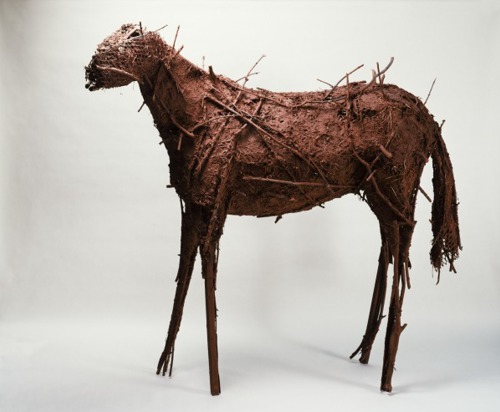
Deborah Butterfield (American, b. 1949), Horse No. 1, 1983, red mud, sticks, metal armature, Henry Meis Endowment and various funds, 1984.94, © Deborah Butterfield/Licensed by VAGA at Artists Rights Society (ARS), NY
Deborah Butterfield makes her sculptures from found materials such as scrap metal, mud, clay, and twigs. Each embodies a particular personality. Whether gentle, frightened, funny, or capricious, each can be understood as a self-portrait of the artist, an exploration of attitudes and feelings. In this sculpture, metal, wood, and mud create the contours of a horse. Twigs stick out from the frame and remind us that the work is composted of debris. Yet the sum of the assembled materials is a majestic presence.
Butterfield began creating naturalistic horse sculptures in the 1970s, when many artists turned away from lifelike representation and toward Conceptual art. Butterfield was born on the same day as the seventy-fifth running of the Kentucky Derby, which she claims to be the inspiration for her tendency to create horses.
This artwork is currently on view in Gallery 105.
Elizabeth Catlett (1915–2012)

Elizabeth Catlett (American, 1915–2012), Phillis Wheatley, 1973, bronze, Museum Purchase: Dr. Sandy Courter Memorial Fund, Lawrence Archer Wachs Fund, A. J. Howe Endowment, Henry Meis Endowment, Phyllis H. Thayer Purchase Fund, Israel and Caroline Wilson Fund, On to the Second Century Endowment, 1999.215, © Catlett Mora Family Trust/Licensed by VAGA at Artists Rights Society (ARS), NY
In 1973, at a conference on women poets, writer Margaret Walker suggested to Elizabeth Catlett that she make a sculpture of Phillis Wheatly, the first published Black poet. Wheatley was born in Senegal and sold into slavery as a child. The Wheatley family of Boston purchased her and provided her with a classical education. After the publication in 1773 of her Poems on Various Subjects Religious and Moral, Phillis Wheatley was emancipated. She was the author of about 145 poems and corresponded with George Washington and other leading statesmen.
Catlett used the only known portrait of Wheatley, the engraved frontispiece to her book, as a guide. She simplified the details of Wheatley’s clothing to produce an image of the poet that is both iconic and contemporary. She also abstracted Wheatley’s features to resemble an African mask, which contributes to the stoic appearance. These subtleties are significant both to Catlett’s interests as an artist and to Wheatley’s legacy.
During her graduate studies at the University of Iowa Catlett was influenced by painter Grant Wood, whom she admired for his belief in the artist’s social responsibility. From Mexican muralists, the African Art collection at the Barnes Foundation, and the European masters, including Van Gogh, Catlett drew on a range of creative traditions. Invigorated by the black power and feminist movements, she has specialized in images of empowered women, often Black or Mexican throughout her career.
This artwork is currently on view in Gallery 211.
CAM Look: bit.ly/CatlettWheatley
Helen Frankenthaler (1928–2011)
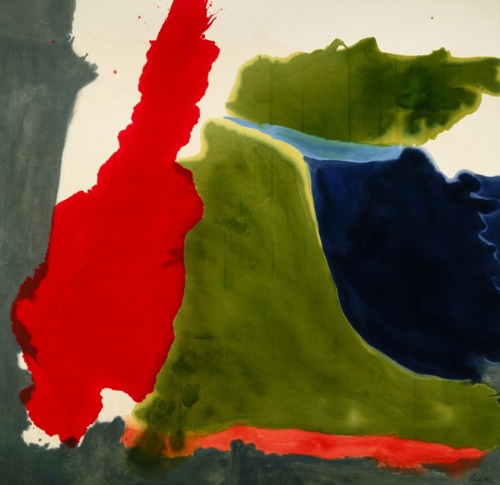
Helen Frankenthaler (American, 1928–2011), Rock Pond, 1962–63, acrylic on canvas, The Edwin and Virginia Irwin Memorial, 1969.11, © 2016 Helen Frankenthaler Foundation, Inc. / Artists Rights Society (ARS), NY
Abstract Expressionism became legendary for painting of monumental scale, bold gestures and decisive action. A mythic, heroic masculinity, akin to James Dean in the movies, surrounded the movement’s male artists, who via media hype, attained iconic stature. This veneration of machismo, epitomized by the image of a muscular Jackson Pollock making his celebrated drip paintings, left little room for the women of this movement.
Experimenting with Pollock’s idea of pouring paint onto a canvas on the floor, Helen Frankenthaler invented a technique that became highly influential: she stained the raw canvas with washes of brilliant color, achieving a delicate equilibrium between accident and control. Typically, as in Rock Pond, her large organic forms evoke the experience of nature and landscape. The museum acknowledged Frankenthaler’s achievement by acquiring Rock Pond just a few years after its completion.
This artwork is currently on view in Gallery 231.
CAM Look: bit.ly/FrankenthalerRockPond
Sophie Guillemard (1780–after 1819)
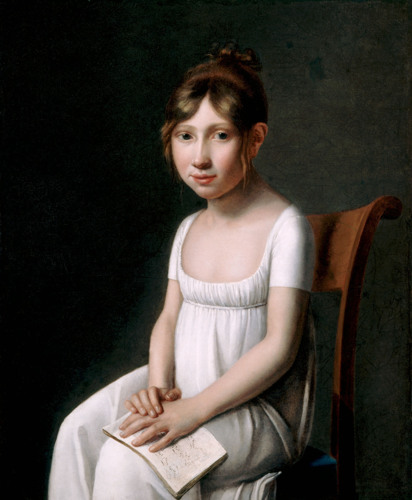
Sophie Guillemard (French, active 1801–1819), Portrait of a Young Lady Distracted from Her Music Lesson, 1801, oil on canvas, John J. Emery Fund, 1917.369
A seated girl turns her head to meet the gaze of the viewer, exuding a quiet confidence, while her hands rest upon a song book in her lap. In 1801 this painting was included in the Paris Salon, the most important annual exhibition of contemporary art at the time, Sophie Guillemard exhibited portraits and history paintings at sixteen subsequent Salons, and was one of more than two hundred female artists to do so in the first quarter of the nineteenth century. In recent years, scholars have reattributed to female artists a number of paintings, including this one, once thought to have been made by famous male contemporaries such as Jacques-Louis David and Jean-Baptiste Regnault.
The clean lines and restrained ornament of the chair and the girl’s dress hint at Egyptian and Roman antiquity and reflect a set of design preferences known as the Empire style that took hold in Napoleonic France (circa 1797– circa 1814).
This artwork is currently on view in Gallery 225.
Caterina van Hemessen (1528–after 1587)
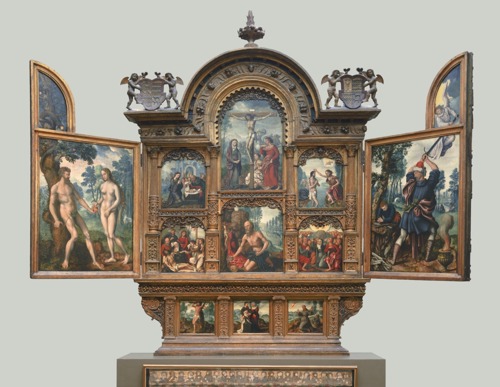
Jan van Hemessen (Flemish, circa 1500–1556/1557) and Katharina van Hemessen (Flemish, b. 1527), Altarpiece with Scenes from the Old and New Testaments (the Tendilla Retablo), 1550s, oil on panel, Fanny Bryce Lehmer and John J. Emery Endowments, 1953.219
This elaborates altarpiece, composed of thirteen painted panels set into a carved wooden frame, was created by a team of Flemish artists for a Spanish patron from Tendilla, about fifty miles east of Madrid. Each scene represents an instance of obedience to God’s will, but the paintings are probably arranged to convey other concepts as well. The scenes on the left side of the opened altarpiece (including Adam and Eve, the Nativity, and the Lamentation), emphasize physical aspects of Christian history, while those on the right (the Sacrifice of Isaac, the Baptism of Christ, and the Ascension) depict more spiritual themes. The three scenes in the center–the Crucifixion, Saint Jerome at Prayer, and the Meeting of Mary and Elizabeth–represent the fusion of the flesh and the spirit. The Annunciation, represented on the exterior of the wings, would have been visible when the altarpiece was closed. Usually, the Virgin Mary is represented on the left and the angel Gabriel on the right, in keeping with this altarpiece’s overall division of “physical” and “spiritual” realms.
At least three artists seem to have contributed to the execution of this complex project. The overall program was probably designed by Jan Sanders van Hemessen and completed by members of his Antwerp studio, including his daughter Caterina. The wooden frame was apparently made in Spain specifically to house the paintings imported from Flanders.
This artwork is currently on view in Gallery 204.
CAM Look: bit.ly/VanHemessenRetablo
Angelica Kauffman (1741–1808)
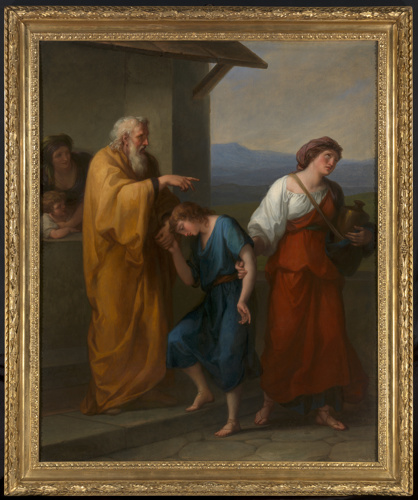
Angelica Kauffman (Swiss, 1741–1808), Abraham Banishing Hagar and Ishmael, 1792, oil on canvas, The Edwin and Virginia H. Irwin Memorial, 2021.43
Three full-length figures clad in primary colors are lyrically composed in a stark setting. The Old Testament patriarch Abraham is banishing Hagar–his wife Sarah’s maid–and their fourteen-year-old son Ishmael, Sarah and young Isaac, her son with Abraham, look on from the house. The idea of unjust exile and the responsibilities borne by Hagar would have resonated with Polisssena Turinetti di Priero, who commissioned this painting in the same year she moved her family to Florence from their ancestral seat in Turin in opposition to the French occupation of that city.
Made at the pinnacle of her career, this is one of only a few religious paintings by Angelica Kauffman. Kauffman achieved success and fame as an artist and intellectual from an early age, moving easily between Italy and England. She was a founding member of the Royal Academy in London, and her time and talents were sought after by an illustrious international clientele.
This artwork is currently on view in Gallery 210.
Bukang Y. Kim (b. 1943)

Bukang Y. Kim (American, b. 1943), Column, 1988, mixed media on canvas, Gift of Dr. Young Ghon Kim, Bukang Yu Kim, and Family, 2015.140
Bukang Y. Kim is a Korean-born American artist based in Cincinnati. She received her early training at Seoul National University and, after coming to the United States in 1970, furthered her studies at the University of Cincinnati. Kim’s work bridges the two cultures that have shaped her identity. Joining her Western training with a deep understanding of East Asian aesthetics and calligraphy, Kim has created a powerful and distinctive pictorial language that speaks of universal harmony and enlightenment.
This painting belongs to a series of works featuring the interior of a traditional Korean house. In Column, lights and space are indistinctly defined. Rich textures of muted color are created from a clay wash added to the paint. The calligraphic Korean writing on the columns and walls (referring to home) enhances the sense of deep nostalgia and longing for her homeland.
This artwork is currently on view in Gallery 124.
Elisabeth Louise Vigée Lebrun (1755–1842)

Elisabeth Louise Vigée Lebrun (French, 1755–1842), Portrait of a Young Woman Playing a Lyre, late 1780s, oil on canvas, Gift of Emilie L. Heine in memory of Mr. and Mrs. John Hauck, 1940.981
Elisabeth Louise Vigée Lebrun was a prominent French portraitist whose career spanned the late eighteenth and early nineteenth centuries. She was a favorite painter of Queen Marie Antoinette and had to flee France amid the turmoil of the French Revolution. Working throughout Europe, Vigée Lebrun continued to paint portraits of aristocrats and prominent society figures, and was elected to art academies in ten cities, an impressive achievement.
Vigée Lebrun often painted her sitters in Neoclassical dress and settings, evoking the arts and culture of Greco-Roman antiquity, which had a profound influence on European art, architecture, literature, and music during this period. In this painting, a young woman wears a Grecian-inspired white gown and holds a lyre; Vigée Lebrun may have painted her patron or model in the guise of Erato, the muse of lyric poetry, whose primary attribute is a stringed instrument.
This artwork is currently on view in Gallery 207.
Mary Louise McLaughlin (1847–1939)
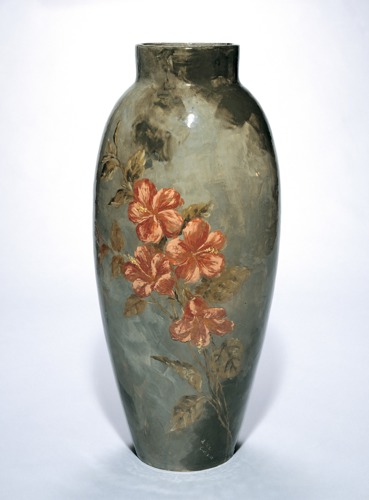
“Ali Baba” Vase, 1880, Mary Louise McLaughlin (American, 1847–1939), decorator, Frederick Dallas Hamilton Road Pottery (American, 1865–1882), manufacturer, earthenware, Gift of Women’s Art Museum Association, 1881.239
Born into a moderately wealthy family, Louise McLaughlin grew up always wanting to be an artist. While she worked in many media, she received her greatest recognition in ceramics. Her how-to book China Painting, published in 1877, was the first of its kind in the nation and launched a ceramics movement led by women. In 1878, she was the first in America to discover the secret technique of decorating pottery under the glaze. Later, in 1896, she began experimenting with porcelain and became the first studio potter in America to work in this most difficult clay to master. Her work in decorating under the glaze and in porcelain won her acclaim in Paris as well as New York. She is a seminal figure in the history of American ceramics, and one of the reasons that the history of American art pottery begins in Cincinnati.
In early August 1879, McLaughlin conceived the idea of making the largest vase in America decorated under the glaze. Decorating under the glaze, instead of over the glaze, was technically difficult because of the colors used for the decoration faded, or fired out, in the glaze firing. Because of its size, the vase was named the Ali Baba vase after the jar that held forty thieves in the book The Arabian Nights. After four unsuccessful attempts, Louise made three Ali Baba vases: this one, another currently in a private collection, and a third whose location is unknown.
When Louise created the Ali Baba vase in February 1880, vessels decorated under the glaze were the most expensive on the market because the technique was so rare and difficult to achieve. The Ali Baba vase was displayed at the Cincinnati Pottery Club’s first reception on May 5, 1880. It was listed for sale at $150 ($2,739 in today’s money). The Ali Baba vase was said to be “without question the finest piece of pottery with the finest decoration ever made in the country.”
This artwork is currently on view in Gallery 114.
Louise Nevelson (1899–1988)
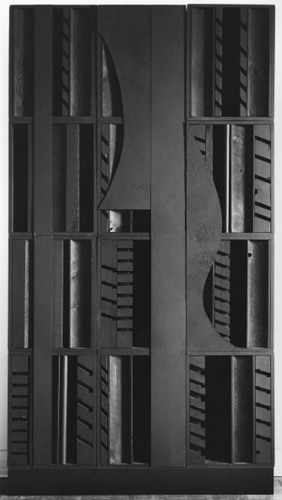
Louise Nevelson (American, 1899–1988), Nightscape III, 1974, wood, Museum Purchase with the aid of funds from the Cincinnati Art Museum Women’s Committee, Pogue’s and the National Endowment for the Arts, 1975.264, © 2016 Estate of Louise Nevelson / Artists Rights Society (ARS), NY
Assembled rather than modeled or carved, and framed in boxes that seem to dissolve form into a pattern of highlights and deep shadows, Louise Nevelson’s remarkable sculptures helped redefine the nature of this medium in the second half of the twentieth century. Taking as her point of departure the notion that found objects can take on new, and often unexpected meanings when placed in a different context, Nevelson freely mixed old scraps of wood and architectural fragments such as moldings and carved balusters with a variety of abstract forms that she had produced herself.
For Nevelson, the selection and arrangement of objects were clearly as important as the forms of the objects themselves. Her genius lay in her ability to bring abstract forms together in tableaux that are able to strike a universal chord within us without yielding any specific meanings. “Only a few basic forms unify the art of all periods,” she has said, “the rest are variations. I build the appearance of a universe from parts of such forms.”
This artwork is currently on view in Gallery 230.
CAM Look: bit.ly/NevelsonNightscape
Elizabeth Nourse (1859–1938)
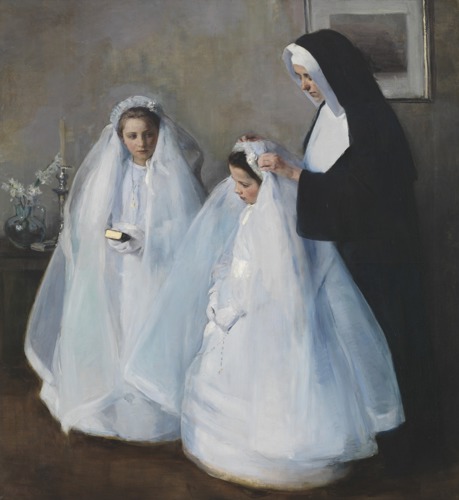
In 1894, Cincinnati native Elizabeth Nourse visited the French region of Brittany for the first time. In the village of Saint Gildas-de-Rhuys, she roomed at the convent of the Sisters of Charity of Saint Louis and made the sketches that she developed into this composition. After its French debut, the painting traveled to exhibitions in Chicago, Philadelphia, Berlin and Pittsburgh, where critics lauded the tour-de-force in the handling of the white dresses. Also noteworthy are the subtlety with which the artist explored the relations of black, white and gray and the arrangement of simple shapes. Varied textures enhance the painting’s visual interest; the filminess of the gowns contrasts with the thick impasto she used for the sashes.
Susanna Hinkle, a prominent Cincinnatian, purchased The First Communion and loaned it to the museum from 1919 to 1935. She then donated it to the Cincinnati Catholic Women’s Association for its headquarters. To support its charitable mission and share the painting with the public, the Association sold it to the museum in 2012.
Elizabeth Nourse (American, 1859–1938), The First Communion (La Première communion), 1895, oil on canvas, Museum Purchase: John J. Emery Endowment and Bequest of Mr. and Mrs. Walter J. Wichgar, 2013.13
This artwork is currently on view in Gallery 120.
Georgia O’Keeffe (1887–1986)
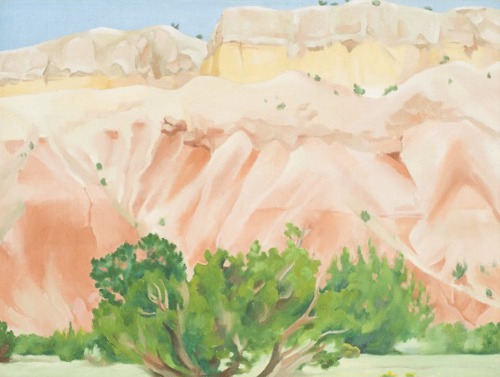
Georgia O’Keeffe (American, 1887–1986), My Back Yard, 1943, oil on canvas, Museum Purchase: The Edwin and Virginia Irwin Memorial, Fanny Bryce Lehmer Endowment, Bequest of Mr. and Mrs. Walter J. Wichgar, John J. Emery Endowment, Mr. and Mrs. Harry S. Leyman Endowment, and Rieveschl Collection Fund, 2013.51, © 2018 Georgia O’Keeffe Museum / Artists Rights Society (ARS), NY
This painting is composed of horizontal bands, with the cooler tones at top and bottom framing the warmer passages in the middle. Georgia O’Keeffe interpreted the otherworldly colors and geological formations of the American Southwest with varying degrees of abstraction. My Back Yard depicts the cliffs as she saw them from Ghost Ranch, sixty miles northwest of Santa Fe. Which she had purchased as a summer house in 1940. Although the painter captured the recognizable contours of the site, O’Keeffe was a composer in paint; she brought the cliffs up close to the surface, nearly filling the canvas with them, and created lyrical gradations of color.
O’Keeffe’s title for this picture, “My Back Yard” is both an ironic and affectionate commentary on the subject. While the image defies the stereotype of the suburban backyard, the title denotes the artist’s intense attachment to the place she experienced every day. She gave this tribute to her adopted home to her younger sister, Claudia.
This artwork is currently on view in Gallery 211.
CAM Look: bit.ly/OkeeffeBackyard
Maria van Oosterwijck (1630–1693)
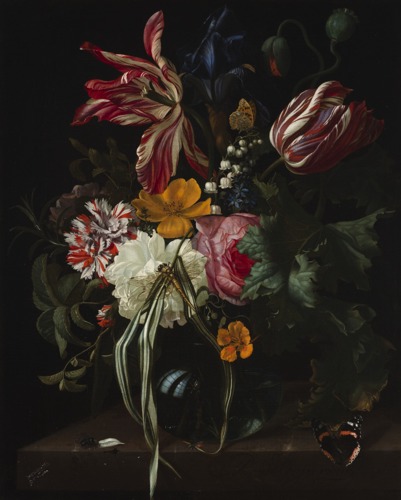
Maria van Oosterwijck (Dutch, 1630–1693), Flower Stil Life, 1669, oil on canvas, Bequest of Mrs. L.W. Scott Alter, 1988.150
In seventeenth-century Holland, intense interest in exotic flowers contributed to the popularity of paintings like this. These paintings functioned on several levels: as colorful decoration, scientific curiosities, and moralizing reminders of the passage of time (cut flowers will soon wilt and fade). They also demonstrated the artist’s powers to preserve otherwise ephemeral beauty.
Maria van Oosterwijck achieved the heights of her profession, being patronized by royal courts across Europe. She trained in Utrecht and by 1671, was most likely established in Amsterdam. She worked slowly; less than two dozen paintings by her survive today. That she was unmarried and among the most successful painters of her generation–a double rarity for a woman of her time–has inspired speculation about her life, which was even novelized in the nineteenth century.
This is one of her earliest dated paintings, but the large signature on the edge of the table reveals a confident, established artist.
This artwork is currently on view in Gallery 205.
CAM Look: bit.ly/MariavanOosterwijck
CAM Access: bit.ly/MariavanOosterwijckAccess
Rengetsu Ōtagaki 太田垣 蓮月 (1791–1875)
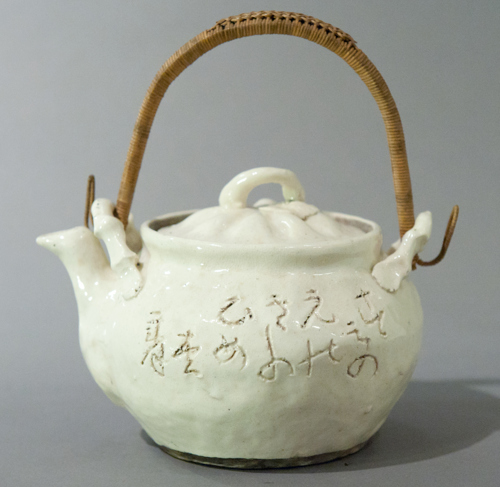
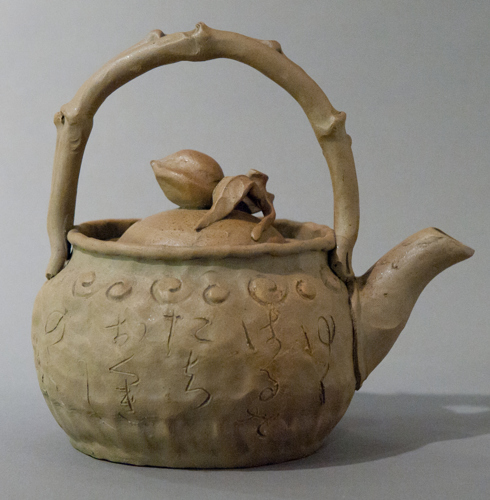
Teapots, 19th Century; circa 1875, Rengetsu Ōtagaki 太田垣 蓮月 (Japanese, 1791–1875), ceramic, Gift of the Rookwood Pottery, 1898.27–28
Rengetsu Ōtagaki 太田垣 蓮月, originally from a samurai family, was adopted at an early age by the Ōtagaki family. In 1823 she became a Buddhist nun and took Rengetsu (“Lotus Moon”) as her name. Her broad interests led her to become one of the greatest Japanese poets, potters, painters and calligraphers of the nineteenth century. The unique spirit of her work came from a life spent in deep meditation on the illusory nature of existence. Her ceramic works became so popular that they continued to inspire many followers after her death and led to the rise of Rengetsu-ware.
Rengetsu often adorned her ceramic works with her own poems written in her elegant kana script. The museum’s two teapots, one white and one brown, fully demonstrate her combined arts of poetry, calligraphy, and simple down-to-earth design. Both teapots were collected by Kitaro Shirayamadani in Japan for Rookwood Pottery and given to the museum in 1898.
This artwork is currently on view in Gallery 151.
Emmy Roth (1885–1942)
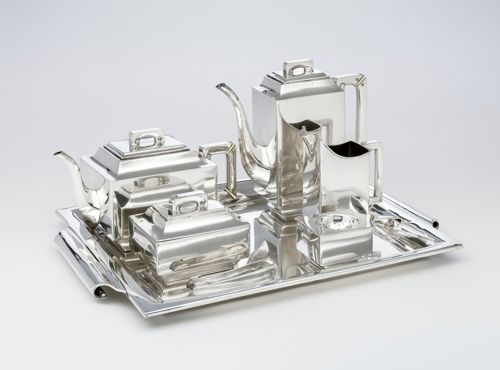
Tea and Coffee Service (7 piece), circa 1930, Emmy Roth (German, 1885–1942), silver and ivory, Museum Purchase: Decorative Arts Deaccession Fund and Cincinnati Art Museum Women’s Committee, 2017.62a–g
Designer and silversmith Emmy Roth created wares reflecting the realities of the modern interwar era in which she and her patrons lived. Her distilled forms were pure in line, spare in decoration, highly functional and carefully handcrafted. For this service, Roth skillfully combined refined, rectilinear shapes with subtle scroll motifs, making it at once austere and organic, a striking and timeless combination.
Roth was one of the first critically acclaimed, published and exhibited modernist female silversmiths to work in Germany. Unfortunately, her achievements were largely forgotten following her death, but recent scholarship has reinstated her well-deserved position in the canon of modern design and metalworking. Examples of Roth’s work are rare, and this is the largest service known to be created by the artist.
This artwork is currently on view in Gallery 228.
Shahzia Sikander (b. 1969)
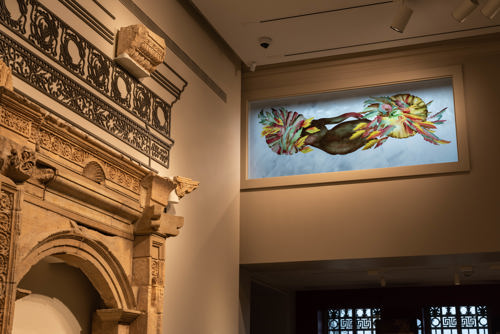
Shahzia Sikander (Pakistani and American, b.1969),Caesura, 2021, painted and laminated glass, Alice Bimel Endowment for Asian Art, 2021.97a–k
Look up in Gallery 147 and you will notice a monumental artwork that occupies the clerestory windows across both sides of this gallery. Commissioned by the museum and inspired by the objects on view, this artwork creates dynamic connections between past and present. Shahzia Sikander is known for innovative works that engage playfully with scale, religion, culture, histories, and iconographies of power. While Sikande’s own identity connects with Pakistan rather than the countries of the modern Middle East, her practice mines cultural influences and forms that play across this vast region.
Sikander’s thoughtful response to the museum’s collection unites the ancient world with contemporary practices in visually imaginative and awe-inspiring ways. A caesura can be described as a pause in poetic form; a brief suspension that offers a chance to reflect. Here the artist brings this rhythmical pause to life in visual form. The lush depictions of the natural world and abstracted figural representation refract forms that have been explored in art from the ancient Middle East, through medieval Islamic cultures, and into the present. By incorporating a contemporary commission into these ancient galleries, we encourage multiple ways of seeing, reading, and understanding cultures–just as Sikander’s layered work suggests movement, color, density, gesture, and ever-shifting light.
This artwork is currently on view in Gallery 147.
CAM Look: bit.ly/CAMShahziaSikander
Shinoda Tōkō (1913–2021)
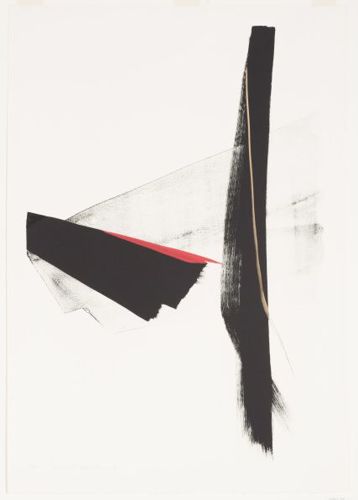
Shinoda Tōkō (Japanese, 1913–2021), Yamato, 1984, hand-colored lithograph with strokes of vermilion and gold, The Howard and Caroline Porter Collection, 1990.982, © Shinoda Tōkō Estate
Shinoda Tōkō was one of the foremost women artists in Japan. Over her seven-decades career she worked in calligraphy, sumi-e (ink paintings) and printmaking. She blended a modern expressionist spirit with the time-honored tradition of calligraphy into a unique artistic vision. In October 1960 she created the first of her lithographs at The Japan Society Lithography Workshop in Tokyo run by Arthur Flory to introduce Japanese artists to the lithographic process. Lithography, a planographic (flat surface) printing process, lent itself to Shinoda’s direct fluid brushwork. With impeccable placement, using a myriad of brushes, her simple bold strokes balance line and form, stillness and motion with delicate grays and intense blacks creating works of elegant visual poetry.
Born in 1913 in Manchuria, China, Shinoda grew up in Gifu, Japan. She began the disciplined study of calligraphy at the age of 6. After World War II, she pursued the more unrestricted medium of sumi-e. In 1954 Shinoda was included in the show Japanese Calligraphy at the Museum of Modern Art in New York. Between 1956 and 1958 she visited the United States where Betty Parsons New York gallery exhibited her work, and she met up-and-coming Abstract Expressionists including Franz Kline and Mark Rothko. After Shinoda’s return to Japan, her paintings and over 300 lithographs with an expressionist flair have received over the decades solo and group exhibitions at home and internationally Shinoda continued to work until her passing on March 1, 2021, at the age of 107.
“Yamato” is a ancient name for Japan. The double bold brushstrokes suggest the archipelago of Japan surrounded by water with the jutting Asian continent off to the left. Tōkō impeccably controlled the pressure, placement and speed of her brushstrokes, ensuring that each piece embodied her signature mark and touch.
This artwork is currently on view in Gallery 213.
Gertrude Vanderbilt Whitney (1875–1942)
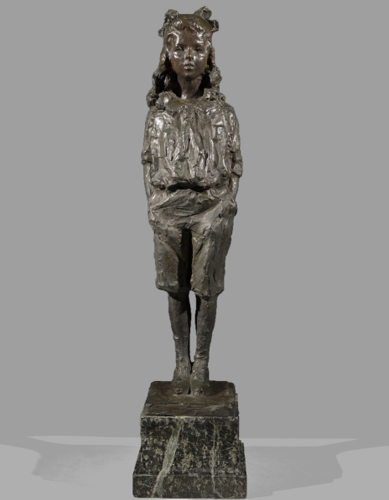
Gertrude Vanderbilt Whitney (American, 1875–1942), Barbara (Wallflower), 1915, bronze, Museum Purchase: Martha and Carl Lindner III Fund, 2017.61, © Estate of Gertrude Vanderbilt Whitney
This sculpture’s impressionistic surface heightens its feeling of spontaneity and informality. The intimate bronze statuette portrays Gertrude Vanderbilt Whitney’s youngest daughter, Barbara Whitney (1903–1982). Barbara’s casual dress and spirited attitude, with her hands shoved into the pockets of her short trousers, mark her as a modern, active and independent-minded adolescent. Barbara’s youthful enthusiasm for sports carried into her adulthood: she owned a horse racing syndicate in Lexington, Kentucky.
Whitney is the celebrated champion of vanguard American artists who founded the Whitney Museum of American Art in New York. Her activities as a professional sculptor, however, are little known today. As a member of high society and a woman, Whitney fought for recognition as an artist and ultimately won public commissions that included the Women’s Titanic Memorial in Washington, D.C., and a monument to Buffalo Bill for the state of Wyoming.
This artwork is currently on view in Gallery 151.
CAM Look: https://bit.ly/GertrudeVanderbiltWhitney






